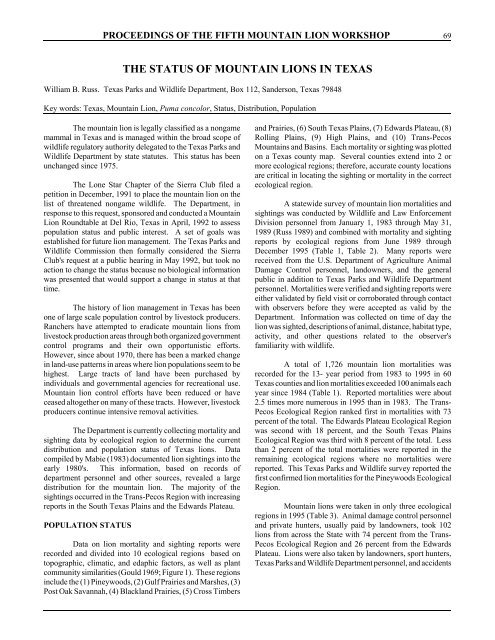Proceedings of the fifth mountain lion workshop: 27
Proceedings of the fifth mountain lion workshop: 27
Proceedings of the fifth mountain lion workshop: 27
Create successful ePaper yourself
Turn your PDF publications into a flip-book with our unique Google optimized e-Paper software.
PROCEEDINGS OF THE FIFTH MOUNTAIN LION WORKSHOP 69<br />
THE STATUS OF MOUNTAIN LIONS IN TEXAS<br />
William B. Russ. Texas Parks and Wildlife Department, Box 112, Sanderson, Texas 79848<br />
Key words: Texas, Mountain Lion, Puma concolor, Status, Distribution, Population<br />
The <strong>mountain</strong> <strong>lion</strong> is legally classified as a nongame<br />
mammal in Texas and is managed within <strong>the</strong> broad scope <strong>of</strong><br />
wildlife regulatory authority delegated to <strong>the</strong> Texas Parks and<br />
Wildlife Department by state statutes. This status has been<br />
unchanged since 1975.<br />
The Lone Star Chapter <strong>of</strong> <strong>the</strong> Sierra Club filed a<br />
petition in December, 1991 to place <strong>the</strong> <strong>mountain</strong> <strong>lion</strong> on <strong>the</strong><br />
list <strong>of</strong> threatened nongame wildlife. The Department, in<br />
response to this request, sponsored and conducted a Mountain<br />
Lion Roundtable at Del Rio, Texas in April, 1992 to assess<br />
population status and public interest. A set <strong>of</strong> goals was<br />
established for future <strong>lion</strong> management. The Texas Parks and<br />
Wildlife Commission <strong>the</strong>n formally considered <strong>the</strong> Sierra<br />
Club's request at a public hearing in May 1992, but took no<br />
action to change <strong>the</strong> status because no biological information<br />
was presented that would support a change in status at that<br />
time.<br />
The history <strong>of</strong> <strong>lion</strong> management in Texas has been<br />
one <strong>of</strong> large scale population control by livestock producers.<br />
Ranchers have attempted to eradicate <strong>mountain</strong> <strong>lion</strong>s from<br />
livestock production areas through both organized government<br />
control programs and <strong>the</strong>ir own opportunistic efforts.<br />
However, since about 1970, <strong>the</strong>re has been a marked change<br />
in land-use patterns in areas where <strong>lion</strong> populations seem to be<br />
highest. Large tracts <strong>of</strong> land have been purchased by<br />
individuals and governmental agencies for recreational use.<br />
Mountain <strong>lion</strong> control efforts have been reduced or have<br />
ceased altoge<strong>the</strong>r on many <strong>of</strong> <strong>the</strong>se tracts. However, livestock<br />
producers continue intensive removal activities.<br />
The Department is currently collecting mortality and<br />
sighting data by ecological region to determine <strong>the</strong> current<br />
distribution and population status <strong>of</strong> Texas <strong>lion</strong>s. Data<br />
compiled by Mabie (1983) documented <strong>lion</strong> sightings into <strong>the</strong><br />
early 1980's. This information, based on records <strong>of</strong><br />
department personnel and o<strong>the</strong>r sources, revealed a large<br />
distribution for <strong>the</strong> <strong>mountain</strong> <strong>lion</strong>. The majority <strong>of</strong> <strong>the</strong><br />
sightings occurred in <strong>the</strong> Trans-Pecos Region with increasing<br />
reports in <strong>the</strong> South Texas Plains and <strong>the</strong> Edwards Plateau.<br />
POPULATION STATUS<br />
Data on <strong>lion</strong> mortality and sighting reports were<br />
recorded and divided into 10 ecological regions based on<br />
topographic, climatic, and edaphic factors, as well as plant<br />
community similarities (Gould 1969; Figure 1). These regions<br />
include <strong>the</strong> (1) Pineywoods, (2) Gulf Prairies and Marshes, (3)<br />
Post Oak Savannah, (4) Blackland Prairies, (5) Cross Timbers<br />
and Prairies, (6) South Texas Plains, (7) Edwards Plateau, (8)<br />
Rolling Plains, (9) High Plains, and (10) Trans-Pecos<br />
Mountains and Basins. Each mortality or sighting was plotted<br />
on a Texas county map. Several counties extend into 2 or<br />
more ecological regions; <strong>the</strong>refore, accurate county locations<br />
are critical in locating <strong>the</strong> sighting or mortality in <strong>the</strong> correct<br />
ecological region.<br />
A statewide survey <strong>of</strong> <strong>mountain</strong> <strong>lion</strong> mortalities and<br />
sightings was conducted by Wildlife and Law Enforcement<br />
Division personnel from January 1, 1983 through May 31,<br />
1989 (Russ 1989) and combined with mortality and sighting<br />
reports by ecological regions from June 1989 through<br />
December 1995 (Table 1, Table 2). Many reports were<br />
received from <strong>the</strong> U.S. Department <strong>of</strong> Agriculture Animal<br />
Damage Control personnel, landowners, and <strong>the</strong> general<br />
public in addition to Texas Parks and Wildlife Department<br />
personnel. Mortalities were verified and sighting reports were<br />
ei<strong>the</strong>r validated by field visit or corroborated through contact<br />
with observers before <strong>the</strong>y were accepted as valid by <strong>the</strong><br />
Department. Information was collected on time <strong>of</strong> day <strong>the</strong><br />
<strong>lion</strong> was sighted, descriptions <strong>of</strong> animal, distance, habitat type,<br />
activity, and o<strong>the</strong>r questions related to <strong>the</strong> observer's<br />
familiarity with wildlife.<br />
A total <strong>of</strong> 1,726 <strong>mountain</strong> <strong>lion</strong> mortalities was<br />
recorded for <strong>the</strong> 13- year period from 1983 to 1995 in 60<br />
Texas counties and <strong>lion</strong> mortalities exceeded 100 animals each<br />
year since 1984 (Table 1). Reported mortalities were about<br />
2.5 times more numerous in 1995 than in 1983. The Trans-<br />
Pecos Ecological Region ranked first in mortalities with 73<br />
percent <strong>of</strong> <strong>the</strong> total. The Edwards Plateau Ecological Region<br />
was second with 18 percent, and <strong>the</strong> South Texas Plains<br />
Ecological Region was third with 8 percent <strong>of</strong> <strong>the</strong> total. Less<br />
than 2 percent <strong>of</strong> <strong>the</strong> total mortalities were reported in <strong>the</strong><br />
remaining ecological regions where no mortalities were<br />
reported. This Texas Parks and Wildlife survey reported <strong>the</strong><br />
first confirmed <strong>lion</strong> mortalities for <strong>the</strong> Pineywoods Ecological<br />
Region.<br />
Mountain <strong>lion</strong>s were taken in only three ecological<br />
regions in 1995 (Table 3). Animal damage control personnel<br />
and private hunters, usually paid by landowners, took 102<br />
<strong>lion</strong>s from across <strong>the</strong> State with 74 percent from <strong>the</strong> Trans-<br />
Pecos Ecological Region and 26 percent from <strong>the</strong> Edwards<br />
Plateau. Lions were also taken by landowners, sport hunters,<br />
Texas Parks and Wildlife Department personnel, and accidents

















